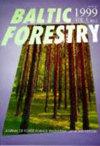波兰冬季条件下储存的原木桩的重量损失
IF 0.6
4区 农林科学
Q3 FORESTRY
引用次数: 0
摘要
我们的工作重点是冬季木材的自然干燥。它旨在比较三种木材的自然干燥过程:作为针叶树种的苏格兰松,作为具有明显心材的环状多孔树种的无柄橡树,以及作为具有扩散多孔结构的边材树种的银桦。这项研究是在波兰中部进行的。我们从一个有41年树龄的林分中收集原木,准备进行间伐。我们把原木随意堆成一堆。实验于2016年11月30日至2017年4月4日进行。在整个实验过程中,每两天对所有样品进行单独测量。我们发现,在实验过程中,原木的重量减轻了,尤其是松树(占总质量的12%),橡树和桦树(7%)的重量减轻得更少。上个月(春季)我们录得最大跌幅。松木的含水率下降幅度最大,橡木心材的含水率降低幅度最小。逐步回归模型解释了58%的天气影响。相对湿度是最显著的因素(0.58),其次是温度和风。我们观察到,在测试物种中,重量损失和直径有不同程度的关系,这可能取决于边材面积。我们的观察表明,冬季的天然木材干燥是一个缓慢的过程,在春季会加快。关键词:自然干燥;木桩;木材储存;含水率。本文章由计算机程序翻译,如有差异,请以英文原文为准。
Weight loss of logwood piles stored under winter conditions in Poland
Our work focuses on the natural drying of woods in winter. It aimed to compare the natural drying process of three wood species: Scots pine as coniferous species, sessile oak as ring-porous species with a marked heartwood and silver birch as a sapwood species with a diffuse-porous structure. The research was carried out in central Poland. We collected logs from a 41-year-old stand destined for thinning. We stacked the logs randomly in one pile. The experiment took place between November 30, 2016 and April 4, 2017. All the samples were measured individually every two days throughout the experiment. We found logs lost weight during the experiment, especially pine (12% of total mass), less so oak and birch (7%). We recorded the biggest decrease during the last month (in spring). The wood’s moisture content decreased the most in pine and the least in oak heartwood. The stepwise regression model explains the impact of weather at 58%. Relative humidity was the most significant factor (0.58), followed by temperature and wind. We observed that weight loss and diameter are related to different degrees in the tested species, which probably depends on the sapwood area. Our observations show that natural wood drying in winter is a slow process that speeds up in the spring. Keywords: natural drying, woodpiles, wood storage, moisture content.
求助全文
通过发布文献求助,成功后即可免费获取论文全文。
去求助
来源期刊

Baltic Forestry
农林科学-林学
CiteScore
1.60
自引率
0.00%
发文量
23
审稿时长
>12 weeks
期刊介绍:
The journal welcomes the original articles as well as short reports, review papers on forestry and forest science throughout the Baltic Sea region and elsewhere in the area of boreal and temperate forests. The Baltic Sea region is rather unique through its intrinsic environment and distinguished geographical and social conditions. A temperate climate, transitional and continental, has influenced formation of the mixed coniferous and deciduous stands of high productivity and biological diversity. The forest science has been affected by the ideas from both the East and West.
In 1995, Forest Research Institutes and Universities from Estonia, Latvia and Lithuania
joined their efforts to publish BALTIC FORESTRY.
 求助内容:
求助内容: 应助结果提醒方式:
应助结果提醒方式:


